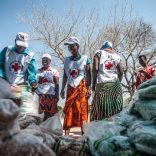Combined team from Mozambique, Kenya wins 34t Christof Heyns African Human Rights Moot Court ...
Mozambique: More than 1,500 displaced by Dikeledi need urgent help

Image: OCHA Regional Office for Southern and Eastern Africa (ROSEA) @UNOCHA_ROSEA/ X
More than 1,500 people who have been living for a week in displacement camps in northern Mozambique, victims of cyclone Dikeledi, need urgent support, the International Organisation for Migration (IOM) said on Wednesday.
The cyclone that hit the province of Nampula on 13 January impacted the district of Mossuril the hardest, “seriously affecting” 249,787 people among 49,407 families.
“The districts of Mossuril, Ilha de Moçambique, Monapo, Mogincual, Liupo, Angoche and Larde were the hardest hit, with Mossuril suffering almost total destruction,” the organisation said in its latest report on cyclone Dikeledi.
The IOM adds that “following the cyclone, ten temporary accommodation facilities were set up in Nampula province to accommodate the displaced”.
However, it said that currently “only three of these facilities remain operational” after the facilities in Monapo and Mogincual were “closed as people returned to rebuild their homes.”
The operational camps are located in the Mossuril district, at the Muanona II and Chocas Mar schools, as well as the Tatiana mosque, “housing a total of 296 families”, with 1,503 people.
“The most urgent needs in the facilities include food, non-food items, hygiene kits, mosquito nets and tarpaulins. The lack of nearby water sources and the need for shelter kits for reconstruction are critical concerns. Cases of diarrhoea have been reported due to the consumption of contaminated water, highlighting the need for hygiene and cleaning kits,” warns the IOM.
At least 11 people died, and almost 20,000 homes were destroyed in the aftermath of tropical cyclone Dikeledi, according to the latest official figures from the Mozambican authorities.
According to a report by the National Institute for Disaster Risk Management (INGD), preliminary data up to Saturday show that the cyclone affected almost 250,000 people, with 27,470 houses partially destroyed and 19,751 totally destroyed. Additionally, 95 houses were flooded, and 44 health centres were affected.
The INGD’s assessment also points to 129 schools affected by the cyclone, including 371 classrooms and 807 teachers. It also points to 67 kilometres of road, 115 damaged boats, and 2,278 fallen medium-voltage poles.
Dikeledi, the second cyclone to hit northern Mozambique in the space of a month, hit the district of Mossuril on 13 January, already at category 3 (on a scale of 1 to 5), with winds of up to 195 kilometres per hour.
Mozambique is considered one of the countries most severely affected by climate change in the world, facing cyclical floods and tropical cyclones during the rainy season, which runs from October to April.
🌀#Dikeledi is the 2nd cyclone to hit #Mozambique in a month.
It’s had devastating impact on the districts it passed through.
Humanitarian stocks are drawn out, forcing partners to prioritize among multiple responses.
Urgent support is needed❗️⬇️https://t.co/kM5hTp0Uzm pic.twitter.com/RwXEELUQnW
— OCHA Southern & Eastern Africa (@UNOCHA_ROSEA) January 22, 2025













Leave a Reply
Be the First to Comment!
You must be logged in to post a comment.
You must be logged in to post a comment.